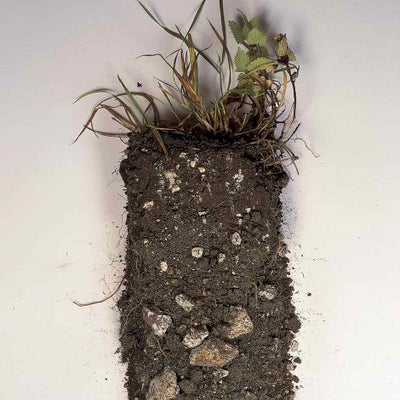
Quick facts
Chalky soils have a pH of 7.1 or above
Water in chalky areas is described as ‘hard’
Calcicoles are plants which can tolerate soil with a high lime content (lime-loving) e.g Syringa
Calcifuges are plants which will not grow normally in soil with a high lime content (lime-hating) e.g Rhododendron
Identifying chalky soil
Chalky soils are highly variable and range from gravelly to clay-like. The clay-like element may in fact be mainly finely divided calcium carbonate making it very poor for plant growth. However where true clay is present in the soil, nutrient levels may be higher and the water holding capacity greater.
Chalky soils can be identified by:
- Chalky or lime-rich soils may be light or heavy but are largely made up of calcium carbonate and are very alkaline (they have a of 7.1-8.0)
- If soil froths when placed in a jar of vinegar, then it contains free calcium carbonate (chalk) or limestone and is lime rich
- Very chalky soils may contain lumps of visible chalky, white stones and often large sharp flints which can easy split. Limestone soils contain lumps of limestone
Gardening with chalky soil
Naturally lime-rich soils contain chalk and limestone in excess, and are often associated with Downland, herb-rich pastures and chalk and limestone woodlands.
Where to see chalky soil gardens:
Hidcote Manor, Chipping Camden, Gloucestershire National Trust
Highdown, Nr Worthing, West Sussex (the late Sir Frederick Stern’s chalk garden)
University Botanic Garden, Cambridge
Waddesdon Manor, nr Aylesbury, Buckinghamshire National Trust
Light chalky soils are:
- Often full of stones
- Can be severely dry in summer
- Often poor in nutrients as both manganese and iron can be “locked up” in the soil so that they become unavailable to plants
- Shallow and light (but easier to cultivate because of their weight and looser construction than “heavy” clay)
But on the plus side;
- Flooding is rare on light alkaline soils because of their elevation and porosity
- They warm up quickly in spring
- With good manuring and fertiliser that can be moderately fertile and ideal for growing a wide range of plants
- Brassicas are less likely to suffer from clubroot in chalky soils
Techniques and tips if you garden on light chalky soil:
- When wet, chalky soils may become sticky and unworkable, but they can be cultivated soon afterwards without doing serious damage (unlike clay soils)
- Smaller plants get established more quickly than more mature specimens
- Mediterranean and prairie plants should grow well on chalky soils
- Avoid acid-loving plants such as camellias and rhododendrons unless you are prepared to grow them in containers. For plant ideas see our page on plants for chalky soils
How to improve chalky soil
Five steps to improving chalky soils:
- Dig in plenty of organic matter to help improve moisture retention and humus levels in the soil (this can break down and disappear very quickly)
- Chalk and limestone subsoils are usually deeply fissured and tree and shrub roots find moistre readily, but in some cases it may be nexcessary to break up the sub-soil to get sufficient depth to plant woody plants
- Apply fertilisers
- plants with organic matter to conserve moisture
- Green manure such as crimson clover (Trifolium incarnatum), vetch and bitter blue lupin (Lupinus angustifolius) can be grown to help fix nitrogen in the vegetable garden and before planting elsewhere
Note: It is not practical to reduce alkalinity in chalky soils by adding sulphur because huge quantities of sulphur would be required over many years to counter the free calcium carbonate.
Correcting problems
It is more difficult to lower soil (i.e. reduce alkalinity) than it is to raise the pH (i.e. increase alkalinity). Consequently, lowering the pH is only practical in slightly alkaline soils. Where attempts are made to reduce alkalinity, the soil should be checked annually to monitor the change in pH and repeat the treatment if necessary.
To a degree, lime-induced chlorosis (typified by yellowing between the veins) can be rectified by applying sequestered iron in a liquid form, which also contains manganese and magnesium. However, if it becomes apparent this is necessary on an annual basis then serious consideration should be made to either growing the affected plant in a container with lime-free (ericaceous) or replacing with plants suited to chalky soils.
On very shallow soils (less than 10cm/4in) over chalk, it may be necessary to increase the growing depth by importing topsoil. For lawns the topsoil depth should be at least 10-15cm (4-6in); for borders 20-30cm (8in-1ft); and for shrub beds >45cm (18in).









